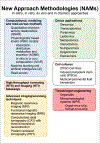New approach methodologies in human regulatory toxicology - Not if, but how and when!
- PMID: 37422975
- PMCID: PMC10858683
- DOI: 10.1016/j.envint.2023.108082
New approach methodologies in human regulatory toxicology - Not if, but how and when!
Abstract
The predominantly animal-centric approach of chemical safety assessment has increasingly come under pressure. Society is questioning overall performance, sustainability, continued relevance for human health risk assessment and ethics of this system, demanding a change of paradigm. At the same time, the scientific toolbox used for risk assessment is continuously enriched by the development of "New Approach Methodologies" (NAMs). While this term does not define the age or the state of readiness of the innovation, it covers a wide range of methods, including quantitative structure-activity relationship (QSAR) predictions, high-throughput screening (HTS) bioassays, omics applications, cell cultures, organoids, microphysiological systems (MPS), machine learning models and artificial intelligence (AI). In addition to promising faster and more efficient toxicity testing, NAMs have the potential to fundamentally transform today's regulatory work by allowing more human-relevant decision-making in terms of both hazard and exposure assessment. Yet, several obstacles hamper a broader application of NAMs in current regulatory risk assessment. Constraints in addressing repeated-dose toxicity, with particular reference to the chronic toxicity, and hesitance from relevant stakeholders, are major challenges for the implementation of NAMs in a broader context. Moreover, issues regarding predictivity, reproducibility and quantification need to be addressed and regulatory and legislative frameworks need to be adapted to NAMs. The conceptual perspective presented here has its focus on hazard assessment and is grounded on the main findings and conclusions from a symposium and workshop held in Berlin in November 2021. It intends to provide further insights into how NAMs can be gradually integrated into chemical risk assessment aimed at protection of human health, until eventually the current paradigm is replaced by an animal-free "Next Generation Risk Assessment" (NGRA).
Keywords: Chemical safety; Human health protection; New approach methodologies; Next generation risk assessment; Regulatory risk assessment; Regulatory toxicology.
Copyright © 2023 German Federal Institute for Risk Assessment. Published by Elsevier Ltd.. All rights reserved.
Conflict of interest statement
Declaration of Competing Interest The authors declare the following financial interests/personal relationships which may be considered as potential competing interests: Roland Grafstroem reports a relationship with Predictomics AB that includes: equity or stocks. Rob Roggeband reports a relationship with The European Partnership for Alternative Approaches to Animal Testing that includes: board membership. Thomas Hartung reports a relationship with Underwriters Laboratories (UL) that includes: consulting or advisory. Thomas Hartung reports a relationship with ToxTrack LLC that includes: consulting or advisory and equity or stocks. Thomas Hartung reports a relationship with AxoSim that includes: consulting or advisory and equity or stocks. Roland Grafstroem has patent #Patent US10556323B2 and Patent EP3149204 licensed to Licensee. Thomas Hartung has patent licensed to Licensee. All other authors declare no competing interests.
Figures




References
-
- Ankley GT, Bennett RS, Erickson RJ, Hoff DJ, Hornung MW, Johnson RD, Mount DR, Nichols JW, Russom CL, Schmieder PK, Serrrano JA, Tietge JE, Villeneuve DL, 2010. Adverse outcome pathways: a conceptual framework to support ecotoxicology research and risk assessment. Environ. Toxicol. Chem 29, 730–741. - PubMed
-
- Ball N, Cronin MT, Shen J, Blackburn K, Booth ED, Bouhifd M, Donley E, Egnash L, Hastings C, Juberg DR, Kleensang A, Kleinstreuer N, Kroese ED, Lee AC, Luechtefeld T, Maertens A, Marty S, Naciff JM, Palmer J, Pamies D, Penman M, Richarz AN, Russo DP, Stuard SB, Patlewicz G, van Ravenzwaay B, Wu S, Zhu H, Hartung T, 2016. Toward good read-across practice (GRAP) guidance. ALTEX 33, 149–166. - PMC - PubMed
-
- Ball N, Madden J, Paini A, Mathea M, Palmer AD, Sperber S, Hartung T, van Ravenzwaay B, 2020. Key read across framework components and biology based improvements. Mutat. Res./Genet. Toxicol. Environ. Mutagen 853, 503172. - PubMed
-
- Bal-Price A, Hogberg HT, Crofton KM, Daneshian M, FitzGerald RE, Fritsche E, Heinonen T, Hougaard Bennekou S, Klima S, Piersma AH, Sachana M, Shafer TJ, Terron A, Monnet-Tschudi F, Viviani B, Waldmann T, Westerink RHS, Wilks MF, Witters H, Zurich MG, Leist M, 2018. Recommendation on test readiness criteria for new approach methods in toxicology: exemplified for developmental neurotoxicity. ALTEX 35, 306–352. - PMC - PubMed
Publication types
MeSH terms
Grants and funding
LinkOut - more resources
Full Text Sources

